This is a list of luminous blue variable stars in order of their distance from Earth.[1][2][3]
List
Milky Way galaxy (confirmed LBVs)
| Star system
|
Nebula
|
Median distance (ly)
|
Stars in system
|
Spectral type
|
Apparent magnitude (V)
|
Comments and references
|
| P Cygni (34 Cygni)
|
|
5,251 |
1 |
B1-2 Ia-0ep |
4.82 |
The closest luminous blue variable star to Earth
|
| V4029 Sagittarii (HD 168607)
|
|
6,000
|
1
|
B9Ia+
|
8.12 to 8.29
|
[4][5] near the Omega Nebula
|
| V905 Scorpii (HD 160529)
|
|
6,100
|
1
|
LBV
|
6.66
|
[4][5]
|
| Eta Carinae (Eta Argus)
|
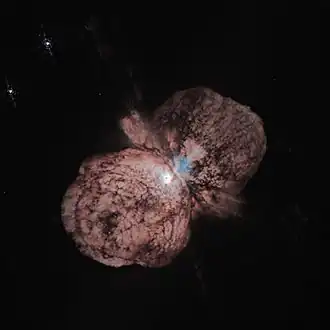 |
7,500 |
2 |
O + B |
−1.0 to ~7.6 |
part of Trumpler 16 in the Carina Nebula
|
| MWC 930 (V446 Scuti)
|

|
11,400
|
1
|
B5/9Iaeq
|
11.51
|
[4]
|
| WRAY 16-137
|
|
12,400
|
1
|
LBV
|
15.5
|
[6][5]
|
| W1-243
|
|
15,000
|
1
|
LBV
|
15.81
|
[4] in Westerlund 1
|
| HR Carinae
|
.png)
|
16,000
|
2
|
LBV+RSG
|
8.42
|
[4][5]
|
| V481 Scuti (LBV G24.73+0.69)
|

|
17,000
|
1
|
LBV_B[e]:
|
|
[4]
|
| AG Carinae
|
.jpg) |
17,000 |
1 |
B |
6.96 |
|
| EM* VRMF 55 (MN44)
|

|
18,000 or 35,000
|
1
|
LBV
|
15
|
[6][7]
|
| [GKF2010] MN48
|

|
20,000
|
1
|
|
15.83
|
[4][5]
|
| GCIRS 34W (WR 101db)
|
|
25,000
|
1
|
Ofpe/WN9
|
|
[6][8] in the Galactic Center
|
| Pistol Star (V4647 Sgr)
|
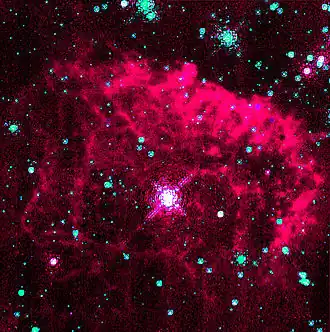 |
25,114 |
1 |
B |
>28 |
part of the Quintuplet Cluster
|
| LBV G0.120-0.048 (V4998 Sgr)
|
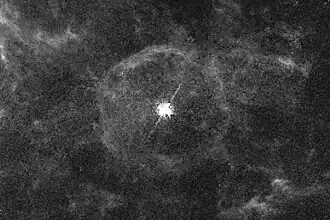
|
26,000
|
1
|
WN5b
|
|
[6] near the Quintuplet Cluster
|
| FMM 362 (V4650 Sgr)
|
|
26,000
|
1
|
LBV
|
|
[6] near the Quintuplet Cluster
|
| AFGL 2298 (V1672 Aql)
|
|
30,000
|
1
|
B8I
|
|
[6]
|
| V432 Carinae (Wray 15-751)
|

|
33,000
|
1
|
LBV
|
10.20
|
Also known as AT 2019ooa[4][5]
|
| [GKM2012] WS1
|

|
39,000
|
1
|
LBV
|
15.31
|
[4][5]
|
| [GKF2010] MN58
|

|
|
1
|
|
|
[6]
|
Milky Way galaxy (candidate LBVs)
| Star system
|
Nebula
|
Median distance (ly)
|
Stars in system
|
Spectral type
|
Apparent magnitude (V)
|
Comments and references
|
| HD 148937
|
_surrounding_HD_148937_as_seen_in_visible_light_(eso2407a).tiff.jpg)
|
3,870
|
1
|
O6f?p
|
6.71
|
[6] central star of NGC 6164
|
| MWC 349A (V1478 Cygni)
|
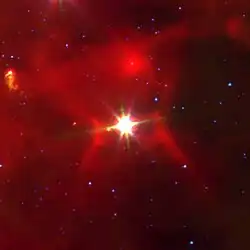
|
4,560
|
2–3
|
B0-1.5 I + B0 III
|
13.15
|
[6] maybe ejected from Cygnus OB2
|
| HD 326823
|
|
4,700 |
1
|
WNpec |
9.03
|
[4][5]
|
| HD 168625
|
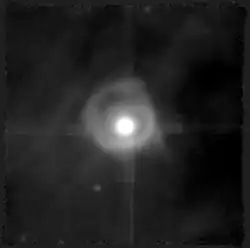
|
5,000
|
1
|
B6Ia+
|
8.30–8.41
|
[4][5] near the Omega Nebula
|
| Cygnus OB2-12
|
|
5,500
|
1
|
B3–4 Ia+
|
11.702
|
[4][5] in Cygnus OB2
|
| AS 314
|
|
5,600
|
1
|
B9Ia
|
9.85
|
[6]
|
| Zeta1 Scorpii
|
|
5,600
|
1
|
B1.5 Iae
|
4.705
|
[4][5]
|
| G79.29+0.46
|
.png)
|
5,700
|
1
|
B:I[e]
|
15.1
|
[4][5] in Cygnus X
|
| WRAY 16-232
|

|
6,850
|
1
|
Be
|
12.5
|
[6][5]
|
| HD 80077
|
|
8,700
|
1
|
B2.5Ia+
|
9.00
|
[4][5]
|
| HD 316285
|

|
10,800
|
1
|
B0Ieq
|
9.60
|
[4][5]
|
| MWC 314 (V1429 Aquilae)
|
|
15,000
|
3
|
B3Ibe
|
9.79 - 10.1
|
[4][5]
|
| [SBW2007] 1
|

|
18,500
|
1
|
B1Iab
|
12.7
|
[4][5]
|
| Sher 25
|

|
21,000
|
1
|
cLBV
|
12.23
|
[4][5] in NGC 3603
|
| W51 LS1 (V1936 Aquilae)
|

|
22,000
|
1
|
O4I
|
15.1
|
[4][5]
|
| WRAY 17-96
|
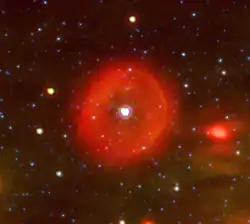
|
22,000
|
1
|
cLBV
|
~13.0
|
[4][5]
|
| [B61] 2
|

|
22,000
|
1
|
LBV_B[e]:
|
15.00
|
[6][5]
|
| WR 102ka
|
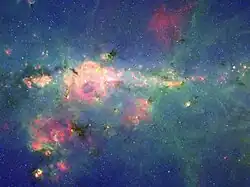
|
26,000
|
1
|
WN10
|
|
[6] near the Galactic Center
|
| GCIRS 16SW
|
|
27,000
|
1
|
Ofpe/WN9
|
|
[6] in the Galactic Center
|
| LBV 1806−20
|
|
28,000
|
1
|
cLBV
|
|
[6] part of the 1806−20 cluster
|
| Hen 3-519
|
.jpg)
|
28,000
|
1
|
WN11h
|
10.85
|
[4][5]
|
| MSX6C G026.4700+00.0207
|

|
30,000
|
1
|
LBV_B
|
|
[6][9]
|
Magellanic Clouds
The Large Magellanic Cloud (LMC) is around 163 kly distant and the Small Magellanic Cloud (SMC) is around 204 kly distant
| Host galaxy
|
Star system
|
Stars in system
|
Spectral type
|
Apparent magnitude (V)
|
Comments and references
|
| LMC
|
S Doradus |
1 |
B8/9eq – F0/5:Iae |
8.6 – 11.5 |
|
| LMC
|
HD 269858 (R127) |
1 |
B |
10.15 |
|
| LMC
|
HD 269006 (R71)
|
1
|
LBV
|
10.55
|
[6]
|
| LMC
|
HD 269216 (SK −69 75)
|
1
|
OBe
|
11.123
|
[6]
|
| LMC
|
HD 269582 (SK −69 142a)
|
1
|
WN10h
|
11.093
|
[6]
|
| LMC
|
HD 269662 (R110)
|
1
|
A0Ia
|
10.28
|
[6]
|
| LMC
|
HD 269700 (R116)
|
1
|
B1.5Iaeq
|
10.54
|
[6]
|
| LMC
|
R143 (CPD-69 463)
|
1
|
F7Ia
|
12.014
|
[6]
|
| SMC
|
HD 5980 (R14)
|
3
|
WN4+O7I:
|
11.31
|
[6]
|
| SMC
|
HD 6884 (R40)
|
1
|
B9Ia0ek
|
10.2
|
[6]
|
Andromeda Galaxy and Triangulum Galaxy
The Andromeda Galaxy (M31) is 2.5 Mly distant and the Triangulum Galaxy is around 3.2 Mly distant
| Host galaxy
|
Star system
|
Stars in system
|
Spectral type
|
Apparent magnitude (V)
|
Comments and references
|
| Andromeda
|
LGGS J004051.59+403303.0 |
1 |
LBV |
16.989
|
[6]
|
| Andromeda
|
AE Andromedae (HV 4476)
|
1
|
LBV
|
17.0–17.9
|
[6]
|
| Andromeda
|
AF Andromedae (HV 4013)
|
1
|
LBV
|
17.325
|
[6]
|
| Andromeda
|
Var 15 ([WB92a] 370)
|
1
|
LBV
|
18.450
|
[6]
|
| Andromeda
|
Var A-1
|
1
|
LBV
|
17.143
|
[6]
|
| Andromeda
|
UCAC4 660-003111
|
1
|
LBV
|
16.39
|
[6]
|
| Triangulum
|
Var C
|
1
|
LBV
|
16.429
|
[6]
|
| Triangulum
|
Var B
|
1
|
LBV
|
16.208
|
[6]
|
| Triangulum
|
Var 83
|
1
|
LBV
|
15.4–16.6
|
[6]
|
| Triangulum
|
Var 2 (Y Trianguli)
|
1
|
Ofpe/WN9
|
18.22
|
[6]
|
| Triangulum
|
Romano’s Star (M33 V0532)
|
1
|
Ofpe/WN9
|
16.5–18.8
|
[6]
|
Single LBV Galaxies
| Host Galaxy
|
Star system
|
Median distance (ly)
|
Stars in system
|
Spectral type
|
Apparent magnitude (V)
|
Comments and references
|
| NGC 3109 |
AT 2018akx |
4,350,000 |
1 |
LBV |
17.5 - 19.28 |
[10]
|
| NGC 2403 |
AT 2016ccd |
9,650,000 |
1 |
LBV |
18.0 - 19.95 |
Also known as SNhunt225.[11][12]
|
| NGC 4214 |
SN 2010U |
9,700,000 |
1 |
LBV |
16 |
[13]
|
| NGC 2363 |
NGC 2363-V1 |
10,800,000 |
1 |
LBV |
17.88 |
One of the most luminous stars known.
|
| NGC 45 |
AT 2018htr |
21,700,000 |
1 |
LBV |
17.469 |
[14]
|
| NGC 2537 |
AT 2017be |
27,900,000 |
1 |
LBV |
18.349 - 18.5 |
Distance from NED using redshift of host galaxy.[15]
|
| NGC 4559 |
AT 2016blu |
29,000,000 |
1 |
LBV |
15.9 – 19 |
Repeated outbursts have been observed since January 2012.[16][17]
|
| NGC 7286 |
AT 2019mil |
32,400,000 |
1 |
LBV |
19 |
Distance from NED using redshift of host galaxy.[18]
|
| UGC 5829 |
AT 2021blu |
43,500,000 |
1 |
LBV |
18.17 - 21.62 |
Distance from NED using redshift of host galaxy.[19]
|
| NGC 4656 |
Variable in NGC 4656 |
43,700,000 |
1 |
LBV |
18 |
Distance from NED using redshift of host galaxy.[20]
|
| NGC 4389 |
AT 2022fnm |
44,700,000 |
1 |
LBV |
18.495 - 17.855 |
Distance from NED using redshift of host galaxy.[21]
|
| ESO 249- G 015 |
AT 2020agp |
47,500,000 |
1 |
LBV |
18.463 |
Distance from NED using redshift of host galaxy.[22]
|
| NGC 908 |
AT 2021ablz |
56,000,000 |
1 |
LBV |
20.58 |
[23]
|
| UGC 5979 |
SN 2007sv |
58,270,000 |
1 |
LBV |
17.4 |
Distance from NED using redshift of host galaxy.[24][25]
|
| IC 5267A |
AT 2019oet |
60,000,000 |
1 |
LBV |
18.335 |
Distance from NED using redshift of host galaxy.[26]
|
| NGC 2748 |
PSN J09132750+7627410 |
61,300,000 |
1 |
LBV |
18.3 |
[27]
|
| NGC 3423 |
AT 2019ahd |
65,600,000 |
1 |
LBV |
17.83 - 18.73 |
Distance from NED using redshift of host galaxy.[28]
|
| NGC 1385 |
AT 2020pju |
66,400,000 |
1 |
LBV |
17.3 - 19.73 |
[29]
|
| NGC 718 |
AT 2019udc |
69,800,000 |
1 |
LBV |
17.53 - 19.09 |
Distance from NED using redshift of host galaxy.[30]
|
| NGC 5334 |
SN 2003gm |
80,196,000 |
1 |
LBV |
17.0 |
Distance from NED using redshift of host galaxy.[31]
|
| SDSS J094838.45+332529.1 |
AT 2020jev |
80,200,000 |
1 |
LBV |
18.74 - 20.33 |
Distance from NED using redshift of host galaxy.[32]
|
| NGC 6509 |
PSN J17592296+0617267 |
95,300,000 |
1 |
LBV |
18.5 |
[33]
|
| NGC 4045 |
AT 2019wbg |
111,500,000 |
1 |
LBV |
17.7 -19.39 |
Repeated outbursts observed since discovery. Distance from NED using redshift of host galaxy.[34]
|
| NGC 4532 |
AT 2017des |
112,800,000 |
1 |
LBV |
18.817 - 19.85 |
Distance from NED using redshift of host galaxy.[35][36]
|
| ESO 602- G 015 |
AT 2022rmk |
113,200,000 |
1 |
LBV |
19.472 - 20.04 |
Distance from NED using redshift of host galaxy.[37]
|
| UGC 9113 |
AT 2017dau |
162,100,000 |
1 |
LBV |
19.32 - 21.32 |
Distance from NED using redshift of host galaxy.[38]
|
| MCG +07-07-070 |
AT 2018kle |
180,200,000 |
1 |
LBV |
18.797 - 18.91 |
Distance from NED using redshift of host galaxy.[39]
|
| UGC 449 |
AT 2022oku |
239,100,000 |
1 |
LBV |
18.781 - 19.49 |
Distance from NED using redshift of host galaxy.[40]
|
| WISEA J010803.49+010843.7 |
AT 2020zmn |
262,600,000 |
1 |
LBV |
20.31 - 20.85 |
Distance from NED using redshift of host galaxy.[41]
|
See also
References
- ^ Brown, A. G. A.; et al. (Gaia collaboration) (August 2018). "Gaia Data Release 2: Summary of the contents and survey properties". Astronomy & Astrophysics. 616. A1. arXiv:1804.09365. Bibcode:2018A&A...616A...1G. doi:10.1051/0004-6361/201833051. Gaia DR2 record for this source at VizieR.
- ^ Barry, Don C. (January 1970), "Spectral Classification of a and F Stars", Astrophysical Journal Supplement, 19: 281, Bibcode:1970ApJS...19..281B, doi:10.1086/190209.
- ^ Frost, E. B. (December 1924), "Fourteen spectroscopic binaries", Astrophysical Journal, 60: 319–320, Bibcode:1924ApJ....60..319F, doi:10.1086/142868.
- ^ a b c d e f g h i j k l m n o p q r s t u v Smith, Nathan; Aghakhanloo, Mojgan; Murphy, Jeremiah W.; Drout, Maria R.; Stassun, Keivan G.; Groh, Jose H. (2019). "On the Gaia DR2 distances for Galactic luminous blue variables". Monthly Notices of the Royal Astronomical Society. 488 (2): 1760–1778. arXiv:1805.03298. Bibcode:2019MNRAS.488.1760S. doi:10.1093/mnras/stz1712. S2CID 119267371.
- ^ a b c d e f g h i j k l m n o p q r s t u v Brown, A. G. A.; et al. (Gaia collaboration) (2021). "Gaia Early Data Release 3: Summary of the contents and survey properties". Astronomy & Astrophysics. 649: A1. arXiv:2012.01533. Bibcode:2021A&A...649A...1G. doi:10.1051/0004-6361/202039657. S2CID 227254300. (Erratum: doi:10.1051/0004-6361/202039657e).
- ^ a b c d e f g h i j k l m n o p q r s t u v w x y z aa ab ac ad ae af ag ah ai Richardson, Noel D.; Mehner, Andrea (2018-07-01). "The 2018 Census of Luminous Blue Variables in the Local Group". Research Notes of the American Astronomical Society. 2 (3): 121. arXiv:1807.04262. Bibcode:2018RNAAS...2..121R. doi:10.3847/2515-5172/aad1f3. ISSN 2515-5172.
- ^ Gvaramadze, V. V.; Kniazev, A. Y.; Berdnikov, L. N. (2015-12-01). "Discovery of a new bona fide luminous blue variable in Norma". Monthly Notices of the Royal Astronomical Society. 454 (4): 3710–3721. arXiv:1509.08931. Bibcode:2015MNRAS.454.3710G. doi:10.1093/mnras/stv2278. ISSN 0035-8711.
- ^ Trippe, S.; Martins, F.; Ott, T.; Paumard, T.; Abuter, R.; Eisenhauer, F.; Gillessen, S.; Genzel, R.; Eckart, A.; Schödel, R. (2006-03-01). "GCIRS34W: an irregular variable in the Galactic Centre". Astronomy and Astrophysics. 448 (1): 305–311. arXiv:astro-ph/0510478. Bibcode:2006A&A...448..305T. doi:10.1051/0004-6361:20053173. ISSN 0004-6361.
- ^ Hou, L. G.; Gao, X. Y. (2014-02-01). "A statistical study of gaseous environment of Spitzer interstellar bubbles". Monthly Notices of the Royal Astronomical Society. 438 (1): 426–437. arXiv:1311.4943. Bibcode:2014MNRAS.438..426H. doi:10.1093/mnras/stt2212. ISSN 0035-8711.
- ^ "AT 2018akx". Transient Name Server. IAU. Retrieved 31 August 2024.
- ^ Bishop, David (9 November 2021). "LBV AT2016ccd in NGC 2403". Rochester Astronomy. Retrieved 31 August 2024.
- ^ "AT 2016ccd". Transient Name Server. IAU. Retrieved 31 August 2024.
- ^ Green, Daniel W. E. (7 February 2010). "Electronic Telegram No. 2163". Central Bureau for Astronomical Telegrams. Dept. of Earth and Planetary Sciences, Harvard University. Retrieved 31 August 2024.
- ^ "AT 2018htr". Transient Name Server. IAU. Retrieved 30 August 2024.
- ^ "AT 2017be". Transient Name Server. IAU. Retrieved 31 August 2024.
- ^ Bishop, David (6 July 2021). "LBV 2016blu in NGC 4559". rochesterastronomy.org. Retrieved 9 August 2021.
- ^ Aghakhanloo, Mojgan; Smith, Nathan; Milne, Peter; Andrews, Jennifer E.; Van Dyk, Schuyler D.; Filippenko, Alexei V.; Jencson, Jacob E.; Lau, Ryan M.; Sand, David J.; Wyatt, Samuel; Zheng, WeiKang (2022). "Recurring outbursts of the supernova impostor AT 2016blu in NGC 4559". Monthly Notices of the Royal Astronomical Society. 526 (1): 456. arXiv:2212.09708. Bibcode:2023MNRAS.526..456A. doi:10.1093/mnras/stad2702.
- ^ "AT 2019mil". Transient Name Server. IAU. Retrieved 30 August 2024.
- ^ "AT 2021blu". Transient Name Server. IAU. Retrieved 30 August 2024.
- ^ Green, Daniel W. E. (24 March 2005). "Circular No. 8498". Central Bureau for Astronomical Telegrams. Dept. of Earth and Planetary Sciences, Harvard University. Retrieved 31 August 2024.
- ^ "AT 2022fnm". Transient Name Server. IAU. Retrieved 15 August 2024.
- ^ "AT 2020agp". Transient Name Server. IAU. Retrieved 30 August 2024.
- ^ "AT 2021ablz". Transient Name Server. IAU. Retrieved 15 August 2024.
- ^ "2007sv". Transient Name Server. IAU. Retrieved 8 December 2024.
- ^
Tartaglia, L.; Pastorello, A.; Taubenberger, S.; Cappellaro, E.; Maund, J. R.; Benetti, S.; Boles, T.; Bufano, F.; Duszanowicz, G.; Elias-Rosa, N.; Harutyunyan, A.; Hermansson, L.; Höflich, P.; Maguire, K.; Navasardyan, H.; Smartt, S. J.; Taddia, F.; Turatto, M. (2015). "Interacting supernovae and supernova impostors. SN 2007sv: The major eruption of a massive star in UGC 5979". Monthly Notices of the Royal Astronomical Society. 447 (1): 117. arXiv:1406.2120. Bibcode:2015MNRAS.447..117T. doi:10.1093/mnras/stu2384.
- ^ "AT 2019oet". Transient Name Server. IAU. Retrieved 31 August 2024.
- ^ Fox, Derek (12 February 2015). "Asiago spectroscopic observation of PSN J09132750+7627410". The Astronomer's Telegram. Retrieved 31 August 2024.
- ^ "AT 2019ahd". Transient Name Server. IAU. Retrieved 30 August 2024.
- ^ "AT 2020pju". Transient Name Server. IAU. Retrieved 15 August 2024.
- ^ "AT 2019udc". Transient Name Server. IAU. Retrieved 30 August 2024.
- ^ "SN 2003gm". Transient Name Server. IAU. Retrieved 23 November 2024.
- ^ "AT 2020jev". Transient Name Server. IAU. Retrieved 30 August 2024.
- ^ Green, Daniel W. E. (June 30, 2011). "Electronic Telegram No. 2754". Central Bureau for Astronomical Telegrams. Retrieved 1 September 2024.
- ^ "AT 2022rmk". Transient Name Server. IAU. Retrieved 29 August 2024.
- ^ "AT 2017des". Transient Name Server. IAU. Retrieved 31 August 2024.
- ^ "Astronote 2022-36". Transient Name Server. IAU. Retrieved 31 August 2024.
- ^ "AT 2022rmk". Transient Name Server. IAU. Retrieved 29 August 2024.
- ^ "AT 2017dau". Transient Name Server. IAU. Retrieved 30 August 2024.
- ^ "AT 2018kle". Transient Name Server. IAU. Retrieved 30 August 2024.
- ^ "AT 2022oku". Transient Name Server. IAU. Retrieved 29 August 2024.
- ^ "AT 2020zmn". Transient Name Server. IAU. Retrieved 30 August 2024.


.png)

.jpg)






